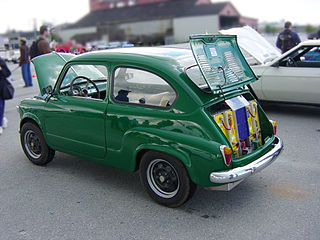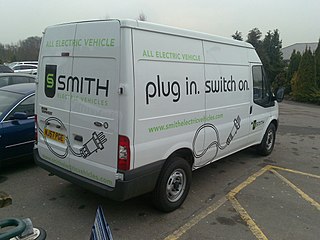Related Research Articles

An electric vehicle (EV) is a vehicle that uses one or more electric motors for propulsion. It can be powered by a collector system, with electricity from extravehicular sources, or it can be powered autonomously by a battery. EVs include, but are not limited to, road and rail vehicles, surface and underwater vessels, electric aircraft and electric spacecraft. For road vehicles, together with other emerging automotive technologies such as autonomous driving, connected vehicles and shared mobility, EVs form a future mobility vision called Connected, Autonomous, Shared and Electric (CASE) Mobility.

A Neighborhood Electric Vehicle (NEV) is a U.S. category for battery electric vehicles that are usually built to have a top speed of 25 miles per hour (40 km/h), and have a maximum loaded weight of 3,000 lb (1,400 kg). Depending on the particular laws of the state, they are legally limited to roads with posted speed limits of 35 miles per hour (56 km/h) or less. NEVs fall under the United States Department of Transportation classification for low-speed vehicles. The non-electric version of the neighborhood electric vehicle is the motorized quadricycle.

The General Motors EV1 was an electric car produced and leased by General Motors from 1996 to 1999. It was the first mass-produced and purpose-designed electric vehicle of the modern era from a major automaker and the first GM car designed to be an electric vehicle from the outset.

The Eliica is a battery electric vehicle prototype or concept car first shown in 2004 and designed by a team at Keio University in Tokyo, led by Professor Hiroshi Shimizu. The 5.1 m (17 ft) car runs on a lithium-ion battery and can accelerate from 0–100 km/h (62 mph) in four seconds. In 2004, the Eliica reached a speed of 370 km/h (230 mph) on Italy's Nardò High Speed Track. The team's goal is to exceed 400 km/h (250 mph), breaking the record set by today's street-legal gasoline-powered vehicles.

A plug-in hybrid electric vehicle (PHEV) is a hybrid electric vehicle whose battery pack can be recharged by plugging a charging cable into an external electric power source, in addition to internally by its on-board internal combustion engine-powered generator. Most PHEVs are passenger cars, but there are also PHEV versions of commercial vehicles and vans, utility trucks, buses, trains, motorcycles, mopeds, and even military vehicles.

In automobile engineering, electric vehicle conversion is the replacement of a car's combustion engine and connected components with an electric motor and batteries, to create an all-electric vehicle (AEV).

The Honda EV Plus was the first battery electric vehicle from a major automaker that did not use lead acid batteries. Roughly 340 EV Plus models were produced and released. Production of the EV Plus was discontinued in 1999 after Honda announced the release of its first hybrid electric vehicle, the Honda Insight.

An electric truck is an electric vehicle powered by batteries designed to transport cargo, carry specialized payloads, or perform other utilitarian work.

The Volvo ECC was an executive luxury concept car built by Volvo in 1992. It was a design exercise in using recycled material and hybrid technology. It was powered by a hybrid electric and gas turbine engine. Many of its lines and general styling were used as inspiration for the first generation Volvo S80. The ECC set a new design language for future Volvo models from the S80 onwards, the most obvious styling feature being the stepped waistline, which was inspired by the similar feature on the 200 Series, whilst retaining some of the angular elements from the 700/900 ranges.
The Progressive Insurance Automotive X PRIZE was a set of competitions, programs and events, from the X Prize Foundation, to "inspire a new generation of super-efficient vehicles that help break America's addiction to oil and stem the effects of climate change." Progressive Insurance was the title sponsor of the prize, the centerpiece of which is the Competition Division, within which a 10-million-dollar purse was divided between the winners of three competitions.

ZENN is a two-seat battery electric vehicle that was produced by the ZENN Motor Company of Canada from 2006 to 2010, designed to qualify as a neighborhood electric vehicle (NEV). It had a range of up to 40 mi (64 km) and was speed-limited to 25 mph (40 km/h). On earlier production models, there was an option of a 'Discovery Pack' which increased the ZENN's range a few miles. In later models it was standard.

ZAP was an American electric vehicle company that designed, produced and marketed vehicles including automobiles, motorcycles, bicycles, scooters, personal watercraft, hovercraft, ATVs, neighborhood electric vehicles and commercial vehicles. The name stands for Zero Air Pollution. The company headquarters were located in Santa Rosa, California. The company is presumed to be defunct. The company's last filing with the California Secretary of State business entity database indicates the agent for service of process resigned on October 26, 2016.

An electric car, battery electric car, or all-electric car is an automobile that is propelled by one or more electric motors, using only energy stored in batteries. Compared to internal combustion engine (ICE) vehicles, electric cars are quieter, have no exhaust emissions, and lower emissions overall. In the United States and the European Union, as of 2020, the total cost of ownership of recent electric vehicles is cheaper than that of equivalent ICE cars, due to lower fueling and maintenance costs. Charging an electric car can be done at a variety of charging stations; these charging stations can be installed in both houses and public areas.

A battery electric vehicle (BEV), pure electric vehicle, only-electric vehicle, fully electric vehicle or all-electric vehicle is a type of electric vehicle (EV) that exclusively uses chemical energy stored in rechargeable battery packs, with no secondary source of propulsion. BEVs use electric motors and motor controllers instead of internal combustion engines (ICEs) for propulsion. They derive all power from battery packs and thus have no internal combustion engine, fuel cell, or fuel tank. BEVs include – but are not limited to – motorcycles, bicycles, scooters, skateboards, railcars, watercraft, forklifts, buses, trucks, and cars.
Apollo Energy Systems is a U.S. multinational alternative energy corporation headquartered in Pompano Beach, Florida, that develops, produces, and markets fuel cell power plants, electric propulsion systems, and alternative energy generation equipment. The company was founded by Robert R. Aronson in 1966 as the Electric Fuel Propulsion Corporation (EFP) in New Orleans, Louisiana. It later became known as the Electric Auto Corporation (EAC), and in 2001 changed to Apollo Energy Systems.

The Renault Z.E. is a line of all-electric cars from Renault. The line began with the Z.E series of concept cars. The first production car is the Renault Fluence Z.E. that was slated for sales to the public in Israel and Denmark by late 2011 as part of the Better Place network, operated by Renault Fluence ZE cars. In 2011 Renault was awarded a contract to supply 15,600 electric vehicles to the French government and the state-owned postal service, La Poste. The vehicles are to contribute to a planned 25,000 electric vehicle fleet owned by the French government.

The Mercedes-Benz BlueZERO concept is Mercedes' attempt at the alternative fuel vehicle movement. The BlueZERO is a flexible concept that has the ability to accommodate the three different types of future alternative fuels: electric, hybrid, and hydrogen fueled. It was first introduced at the 2009 Detroit Auto Show which took place January 11–25. It features a single vehicle architecture that accommodates three models with different electric power-train configurations, each of which are fully developed and ready for testing. The Mercedes-Benz BlueZERO electric drive system gives each model the same performance specifications for acceleration and top speed. The Mercedes-Benz BlueZERO electric drive modular design accelerates from 0 to 100 km/h (62.5 mph) in under 11 seconds, and the top speed is electronically governed to 150 km/h (93 mph) in the interests of optimal range and energy efficiency. Peak torque is 320 N⋅m (236 lb⋅ft) and as with all EVs, maximum torque is available from zero rpm.

The Renault Fluence Z.E. is an electric version of the Renault Fluence compact sedan, part of the Renault Z.E. program of battery electric vehicles. It was unveiled by Renault at the 2009 Frankfurt Motor Show. The Fluence Z.E. is outfitted with a 22 kWh lithium-ion battery which allows a total all-electric range of 185 km (115 mi) measured on the NEDC combined cycle, with speeds up to 135 km/h (84 mph).
Automobili Pininfarina GmbH is a luxury electric vehicle (EV) manufacturer headquartered in Munich, Germany, with roots in the Italian car design firm and coachbuilder Pininfarina SpA. The company also has a design facility and office locations in Turin, Italy. Its first car, the Battista hypercar, has been produced from 2021. It was introduced at the Pebble Beach Concours d'Elegance 2018, and 150 units are planned for production.
References
- 1 2 3 4 5 6 7 8 9 10 11 12 13 The Daily Telegraph, Motoring section, 1 March 2008
- 1 2 3 "Zero emission vans made in Wales". WalesOnline. 16 July 2008. Retrieved 12 October 2009.
- 1 2 "Welsh car could be the future of motoring". WalesOnline. 5 March 2008. Retrieved 12 October 2009.
- 1 2 "Electric Vehicles Group Test". Commercial Motor. 17 July 2008. p. 41.